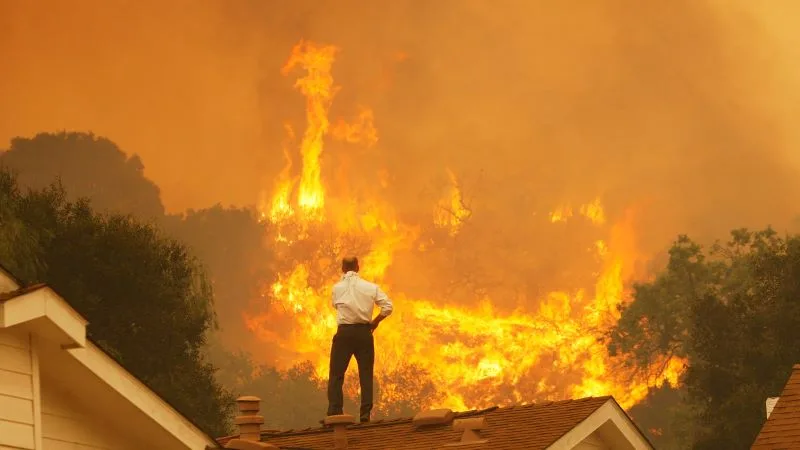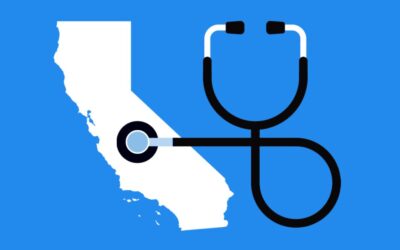
Climate Change and Public Health: A Health Emergency Unfolding in California
Imagine this: by the end of this century, California could experience an additional 40 to 50 days per year where temperatures soar above 95 degrees Fahrenheit. This startling projection isn’t a scene from a dystopian novel; it’s a real consequence of the relentless march of climate change. Our golden state, known for its diverse landscapes and thriving communities, stands at the forefront of an escalating climate emergency.
Climate change isn’t just an environmental issue; it’s a burgeoning public health crisis. From the choking smoke of rampant wildfires to the insidious rise in heat-related illnesses, Californians are living on the front lines of a rapidly changing climate. Our health, our well-being, and our very way of life are under threat.
This blog post is more than just an alarm bell; it’s a call to understanding and action. We aim to peel back the layers of this complex issue, revealing how the changing climate is intricately linked to public health in California. We’ll explore the direct health impacts, the disproportionate effects on vulnerable communities, and the ways in which our healthcare systems are striving to adapt to this new reality.
Our goal is simple yet ambitious: to educate and inform you, the reader, about the pressing challenges we face and the potential solutions at our disposal. In the face of a crisis of this magnitude, knowledge is not just power – it’s a lifeline.
Understanding Climate Change in California
Background: The Fundamentals of Climate Change
Climate change refers to significant, long-term changes in the patterns of temperature, precipitation, wind, and seasons. It’s primarily driven by human activities, notably the burning of fossil fuels like coal, oil, and gas, leading to an increase in greenhouse gases in the Earth’s atmosphere. This buildup acts like a blanket, trapping heat and warming the planet. This global phenomenon has far-reaching impacts, affecting every corner of the world, including our diverse and dynamic state of California.
Local Impact: California’s Climate Challenge
In California, the fingerprints of climate change are both unmistakable and alarming. We are witnessing a range of impacts that have profound implications for our natural environment, our economy, and our health. Here are some of the most striking ways climate change is reshaping our state:
- Wildfires: The frequency and severity of wildfires in California have escalated dramatically. Enhanced by prolonged droughts and hotter temperatures, these fires not only ravage our landscapes but also pose significant health risks due to air pollution and habitat displacement.
- Droughts and Water Scarcity: Longer and more severe droughts are another hallmark of climate change in California. These droughts strain our water supplies, affect agriculture, and disrupt natural ecosystems.
- Rising Sea Levels: As global temperatures rise, so do our ocean levels, posing a threat to coastal communities through increased flooding and erosion.
- Agricultural Impacts: The changing climate is also affecting California’s agricultural sector, with altered growing seasons and increased pestilence, challenging our food supply chain.
Data and Statistics: The Numbers Tell the Tale
The latest statistics paint a vivid picture of climate change’s grip on California:
- Temperature Rise: Over the past century, California’s average temperature has risen by about 1.7 degrees Fahrenheit, with the last decade being the warmest on record.
- Wildfire Statistics: In the 2020 wildfire season alone, over 4 million acres burned in California, an area larger than the state of Connecticut, marking it as the most extensive wildfire season recorded in modern history.
- Drought Data: As of 2023, more than 95% of California faced abnormally dry or drought conditions, severely impacting water resources, agriculture, and wildlife habitats.
This data underscores the urgency of addressing climate change – not as a distant threat, but as a present and escalating crisis that demands immediate and concerted action.

Direct Health Impacts: The Immediate Toll of Climate Change
The health implications of climate change in California are both direct and profound. As temperatures continue to climb, heat-related illnesses such as heatstroke and dehydration are becoming more common. Particularly during heatwaves, emergency rooms across the state report significant spikes in patients suffering from these conditions. But the impact doesn’t stop there.
Poor air quality, exacerbated by frequent wildfires and increased ozone levels, leads to a surge in respiratory problems. Conditions like asthma, bronchitis, and other chronic respiratory diseases are aggravated, leading to higher hospital admission rates. Even for those without pre-existing conditions, the smoky air can cause coughing, throat irritation, and shortness of breath.
Mental Health: The Unseen Scars of Climate Change
The psychological impact of climate change is often overshadowed, but it’s equally critical. The stress and anxiety caused by living through and recovering from climate-induced disasters like wildfires and droughts can lead to long-term psychological trauma. This is especially true for individuals who lose their homes or livelihoods to such events. Moreover, the persistent worry about future disasters and the overall state of the planet contributes to a rise in eco-anxiety, particularly among younger generations.
Vulnerable Populations: Disproportionate Effects
The harsh reality of climate change is that its effects are not felt equally. Vulnerable populations in California – including the elderly, children, and low-income communities – bear the brunt of these challenges:
- Elderly: Older adults are particularly susceptible to heat-related illnesses, and they may also have limited access to resources needed to cope with extreme weather conditions.
- Children: Young children, with their developing bodies and lungs, are more vulnerable to poor air quality. Their dependence on adult caregivers makes them particularly at risk during climate-related emergencies.
- Low-Income Communities: Often residing in areas with fewer resources and higher exposure to pollutants, these communities face greater health risks. Additionally, limited access to healthcare exacerbates the impact of climate-related health issues.
By highlighting these challenges, we recognize the need for targeted interventions and support systems that can help mitigate the disproportionate effects of climate change on these vulnerable groups in our communities.
Climate Change and Healthcare Systems: The Rising Tide of Climate-Related Health Issues
Climate change is placing an unprecedented strain on California’s healthcare systems. As the frequency and severity of climate-related health issues rise, hospitals and clinics face mounting challenges. Heatwaves lead to an influx of heat-related illnesses, while poor air quality from wildfires results in increased respiratory cases. These surges not only put pressure on medical facilities and staff but also stretch the availability of resources like hospital beds and emergency services.
The impact is twofold: immediate treatment of climate-related health problems and the long-term management of exacerbated chronic conditions. This double burden is challenging healthcare providers to rethink capacity and resource allocation.
Emergency Preparedness: Adapting to the New Normal
The increasing regularity of climate-related emergencies – such as wildfires, heatwaves, and droughts – demands a robust response from healthcare systems. There’s a growing need for emergency preparedness plans that specifically address these climate challenges. This includes ensuring adequate staffing during emergencies, creating evacuation protocols for hospitals in high-risk areas, and establishing mobile and resilient healthcare services to reach affected populations swiftly.
Moreover, healthcare providers must be trained to recognize and treat climate-related health conditions effectively. Building resilient healthcare infrastructure, both physically and in terms of human resources, is essential to withstand and respond to the challenges posed by a changing climate.
Insurance Perspective: Navigating the Shifting Landscape
As an insurance professional, I’ve witnessed firsthand how climate change is reshaping the health insurance landscape. There’s an increasing demand for policies that cover a broader range of climate-related health issues. The frequency of climate-related disasters is also leading to a reassessment of risk, which can impact insurance premiums and coverage options.
For consumers, this means navigating a more complex insurance market. It’s becoming crucial to understand the extent of coverage, especially for those living in high-risk areas prone to wildfires or floods. On the flip side, this also presents an opportunity for the insurance industry to innovate and offer products that meet these evolving needs, such as policies with enhanced coverage for climate-related health conditions or telemedicine services in the aftermath of a disaster.
In conclusion, the intersection of climate change and healthcare is multifaceted and evolving. It requires a proactive approach from healthcare systems to manage the current strain and prepare for future challenges. From an insurance perspective, it calls for adaptability and foresight to provide coverage that aligns with the changing health landscape.

Mitigation and Adaptation Strategies: Individual Efforts for a Collective Impact
While climate change is a global issue, individual actions play a pivotal role in mitigating its effects. Every resident of California can contribute to this collective effort through simple yet impactful changes:
- Reducing Carbon Footprint: Simple actions like using public transportation, carpooling, biking, or walking can significantly reduce carbon emissions. Adopting energy-efficient appliances and reducing electricity usage are other ways to make a difference.
- Sustainable Living Choices: Embracing a lifestyle that prioritizes sustainability can have far-reaching effects. This includes reducing waste, recycling, using reusable products, and supporting local and sustainable businesses.
- Water Conservation: In a state grappling with drought, conserving water is crucial. Simple measures like fixing leaks, using water-efficient appliances, and adopting drought-resistant landscaping can help.
- Educating and Influencing Others: Sharing knowledge and encouraging others to adopt eco-friendly practices can amplify the impact of individual efforts.
Community Initiatives: Local Actions Leading the Way
California communities are at the forefront of addressing climate change and its impact on public health:
- Urban Green Spaces: Cities across California are investing in green spaces. These areas not only improve air quality but also provide a buffer against heatwaves and enhance community well-being.
- Pollution Control Measures: Local governments are implementing stricter pollution control measures to improve air quality. This includes regulations on industrial emissions and incentives for using renewable energy sources.
- Community-Based Health Initiatives: Programs focusing on climate-related health education and providing resources for heatwave and poor air quality days are becoming more common, especially in vulnerable communities.
Policy Advocacy: Supporting Change at a Higher Level
While individual and community actions are crucial, systemic change is needed to combat climate change effectively. Readers can play a role in this by:
- Supporting Climate Policies: Advocating for and supporting policies that aim to reduce greenhouse gas emissions and promote renewable energy is essential. This includes policies at the local, state, and federal levels.
- Participating in Public Discourse: Engaging in public discussions, attending town hall meetings, and communicating with elected officials about the importance of climate policies can influence decision-making.
- Voting for Climate Action: Supporting candidates and measures that prioritize climate action and public health in elections can lead to significant policy shifts.

Recap: The Key Takeaways
Our journey through the intricacies of climate change and its profound impact on public health in California reveals a landscape of challenges and opportunities. We’ve explored how the changing climate directly affects our health, from heat-related illnesses to respiratory problems and mental health issues. The disproportionate impact on vulnerable populations, such as the elderly, children, and low-income communities, calls for targeted attention and action.
We delved into the strain on our healthcare systems and the need for greater emergency preparedness to cope with the rising tide of climate-related health challenges. The shifting landscape of health insurance in the face of climate change underscores the need for adaptable and comprehensive coverage.
But amidst these challenges, we also uncovered paths for action and hope. Individual efforts to reduce carbon footprints, embrace sustainable living, and conserve water are vital steps. Community initiatives that create green spaces, enforce pollution control, and foster climate-related health education are making a tangible difference. And at the heart of sustained change lies policy advocacy – supporting and voting for climate-forward policies and leaders.
Call to Action: Be Part of the Solution
This blog post is more than an information source; it’s an invitation for you, the reader, to become an active participant in shaping a healthier, more sustainable future for California. Whether it’s adopting a more eco-friendly lifestyle, getting involved in local initiatives, or raising your voice for policy change, your actions matter. Together, we can confront the challenges posed by climate change and protect the health and well-being of our communities.
Resources: Where to Learn More and Get Involved
To further your journey, here are some resources for more information and ways to engage:
- California Air Resources Board (CARB): Learn about California’s efforts to reduce air pollution and fight climate change.
- Covered California: For insights into health insurance options and coverage in the context of climate change.
- California Department of Public Health – Climate Change and Health: Information on the health impacts of climate change and public health initiatives.
- Local Environmental Advocacy Groups: Join groups in your area working towards environmental conservation and climate action.
We stand at a pivotal moment in California’s history, facing a challenge that will define our future. Let’s rise to this occasion with determination and hope, forging a path towards a healthier, more resilient California.














































